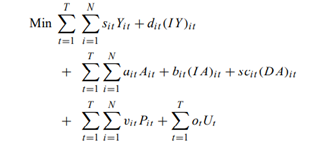Question
A large electronics manufacturing firm that produces a single product is faced with rapid sales growth. Its planning group is developing an overall capacity-expansion strategy,
A large electronics manufacturing firm that produces a single product is faced with rapid sales growth. Its planning group is developing an overall capacity-expansion strategy, that would balance the cost of building new capacity, the cost of operating the new and existing facilities, and the cost associated with unmet demand (that has to be subcontracted outside at a higher cost).
The following model has been proposed to assist in defining an appropriate strategy for the firm.
Decision variables
Yit A binary integer variable that will be 1 if a facility exists at site i in period t, and 0 otherwise.
(I Y )it A binary integer variable that will be 1 if facility is constructed at site i in period t, and 0 otherwise.
Ait Capacity (sq ft) at site i in period t.
(I A)it The increase in capacity at site i in period t.
(D A)it The decrease in capacity at site i in period t.
Pit Total units produced at site i in period t.
Ut Total unmet demand (subcontracted) units in period t.
Forecast parameters
Dt Demand in units in period t.
Cost parameters–Capacity
sit Cost of operating a facility at site i in period t.
dit Cost of building a facility at site i in period t.
ait Cost of occupying 1 sq ft of fully equipped capacity at site i in period t.
bit Cost of increasing capacity by 1 sq ft at site i in period t.
Cit Cost of decreasing capacity by 1 sq ft at site i in period t.
Cost parameters–Production
Ot Cost of unmet demand (subcontracting + opportunity cost) for one unit in period t.
vit Tax-adjusted variable cost (material + labor + taxes) of producing one unit at site i in period t.
Productivity parameters
(pa)it Capacity needed (sq ft years) at site i in period t to produce one unit of the product.
Policy parameters
Fit, Fit Maximum, minimum facility size at site i in period t (if the site exists).
Git Maximum growth (sq ft) of site i in period t.
Objective function
The model’s objective function is to minimize total cost:

Description of constraints
1. Demand constraint
2. Productivity constraint
3. Facility-balance constraint
4. Area-balance constraint
5. Facility-size limits
6. Growth constraint
7. Additional constraints

All variables nonnegative. Explain the choice of decision variables, objective function, and constraints. Make a detailed discussion of the model assumptions. Estimate the number of constraints, continuous variables, and integer variables in the model. Is it feasible to solve the model by standard branch-and-bound procedures?
TN Min sis Yit + dir(IY)it t=l i=l TN + air Air + bi(IA)i + sci(DA) t=1 i=l TN T + vPir + , t=l i=l t=l
Step by Step Solution
There are 3 Steps involved in it
Step: 1

Get Instant Access to Expert-Tailored Solutions
See step-by-step solutions with expert insights and AI powered tools for academic success
Step: 2

Step: 3

Ace Your Homework with AI
Get the answers you need in no time with our AI-driven, step-by-step assistance
Get Started


